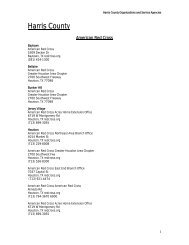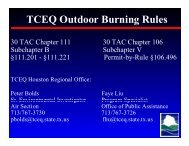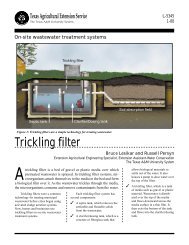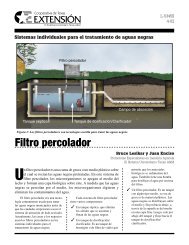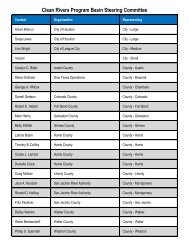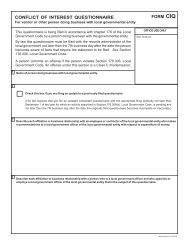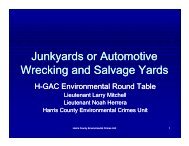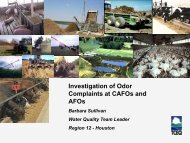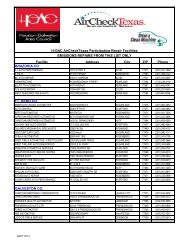Evapotranspiration bed - Department of Biological & Agricultural ...
Evapotranspiration bed - Department of Biological & Agricultural ...
Evapotranspiration bed - Department of Biological & Agricultural ...
Create successful ePaper yourself
Turn your PDF publications into a flip-book with our unique Google optimized e-Paper software.
Grass cover<br />
is important<br />
for transpiration<br />
<strong>of</strong> wastewater<br />
Treatment<br />
In ET <strong>bed</strong> systems, solid materials<br />
are removed from the wastewater<br />
by a septic tank. Then the wastewater<br />
is distributed throughout the ET <strong>bed</strong><br />
system. There, final treatment and<br />
disposal occur when the water<br />
evaporates and plants use nutrients in<br />
the effluent and release moisture<br />
through transpiration.<br />
As the water evaporates, salts,<br />
minerals and solids from the effluent<br />
accumulate in the <strong>bed</strong>. During very<br />
wet periods when evapotranspiration<br />
is low, ET <strong>bed</strong>s store water until drier<br />
periods when it evaporates and<br />
transpires.<br />
Design<br />
An ET <strong>bed</strong> contains storage<br />
trenches, loam backfill around the<br />
trenches and sandy loam soil over the<br />
top <strong>of</strong> the loam backfill for grass<br />
growth. Generally, the required <strong>bed</strong><br />
surface area is divided between two<br />
<strong>bed</strong>s, which allows for switching<br />
between the <strong>bed</strong>s to avoid overloading.<br />
A liner and sand cushion are<br />
placed in the ground, and the storage<br />
system is set on the <strong>bed</strong> bottom.<br />
Generally, the storage system consists<br />
<strong>of</strong> a <strong>bed</strong> <strong>of</strong> rocks or gravel <strong>of</strong> a<br />
uniform size ranging from 3/4-inch to<br />
2 inches in diameter, filling the <strong>bed</strong> to<br />
a depth <strong>of</strong> 12 inches or less, depending<br />
on the <strong>bed</strong>’s overall depth.<br />
Distribution pipes are placed no more<br />
than 4 feet apart and no more than 2<br />
feet from the <strong>bed</strong> walls. The top <strong>of</strong> the<br />
distribution pipe must be flush with<br />
the top <strong>of</strong> the rock media.<br />
Other types <strong>of</strong> media such as tire<br />
chips, or storage systems such as<br />
leaching chambers, may be used for<br />
the storage trenches.<br />
A water-permeable soil barrier (a<br />
geotextile filter fabric) is placed over<br />
the rock. A loam soil is added to fill<br />
the <strong>bed</strong> to within two inches <strong>of</strong> the<br />
top. Selecting the proper soil is<br />
extremely important in building an ET<br />
system. (State regulations classify the<br />
soil as a class II, loamy soil.) The soil<br />
draws the water toward the surface<br />
faster than coarse sand.<br />
Wicks incorporated into the rock<br />
media draw water continuously from<br />
the rocks into the soil and toward the<br />
surface area, where it evaporates or is<br />
taken up by plants. A wick is a<br />
column <strong>of</strong> soil that extends through<br />
the rock media to the bottom <strong>of</strong> the<br />
<strong>bed</strong>. The total wick area should be 10<br />
to 15 percent <strong>of</strong> the <strong>bed</strong> surface and<br />
should be uniformly spaced throughout<br />
the <strong>bed</strong>.<br />
After the loamy soil is in place,<br />
the final two inches are filled with<br />
sandy loam and mounded in the<br />
center with a slope <strong>of</strong> 2 to 4 percent<br />
toward the outside <strong>of</strong> the <strong>bed</strong>. The last<br />
step is to plant vegetation specially<br />
selected to transpire the most water,<br />
such as bermudagrass or St. Augustine<br />
grass. Placing grass sod over the<br />
<strong>bed</strong> may be the best approach to<br />
establishing grass there. Using seed<br />
may let the mounded soil wash away<br />
during heavy rainfall before the grass<br />
is established. Larger plants with<br />
shallow root systems, such as evergreen<br />
bushes, may also be used to<br />
help take up water.<br />
If you use grasses with dormant<br />
periods, be sure to provide adequate<br />
vegetation on the <strong>bed</strong>s during these<br />
periods. A common solution is<br />
overseeding with winter grasses to<br />
provide year-round transpiration.<br />
How to keep it working<br />
A valve connecting the two <strong>bed</strong>s<br />
allows you to alternate the wastewater<br />
inflow between each <strong>bed</strong>. When one<br />
<strong>bed</strong> becomes saturated, turn the valve<br />
to send effluent into the other underloaded<br />
<strong>bed</strong>. An inspection port added



